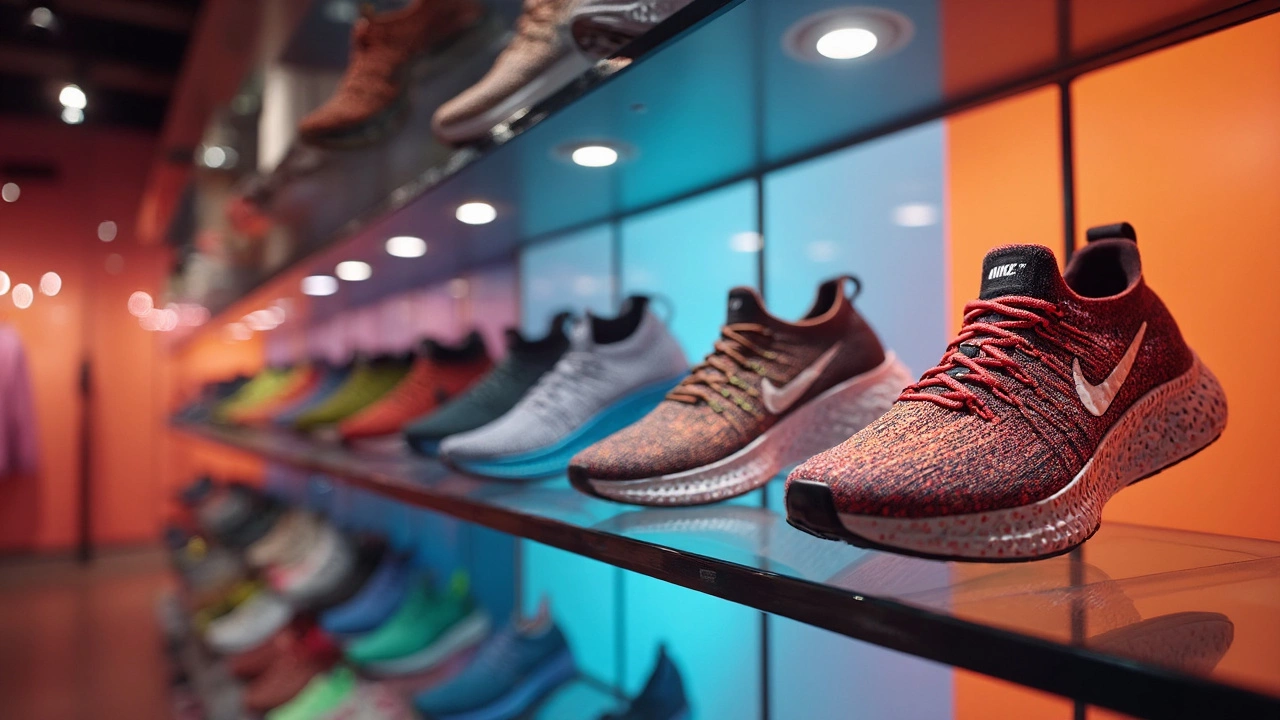Do Adidas Run Different than Nike?

Picking the right running shoe can be as complicated as choosing a favorite flavor of ice cream—and when it comes to Adidas and Nike, the choice is just as delightful but nuanced. Both brands are giants in the sneaker world, each with their own loyal fanbase and unique offerings. But what sets their shoes apart? Well, let's break it down, starting with the basics that any runner should consider.
Adidas often leans towards a snug fit, aiming for a sock-like feel, thanks to their Primeknit and Boost technologies. This can be a game-changer if you prefer a more connected feeling with your shoe. On the other hand, Nike offers a wider range of fits and shapes, catering well to those with broader feet or who enjoy a bit more room to wiggle their toes.
For the casual runner who may not have thought much about shoe tech, terms like 'Boost' and 'Flyknit' might sound like buzzwords. But there's actual substance here—Adidas' Boost technology is all about energy return, offering a springy cushion that feels light and bouncy. Nike's Flyknit, meanwhile, focuses on lightweight support and breathability, almost like you're running barefoot.
Considering what each brand brings to the table in performance and durability, Adidas shoes are often praised for their longevity, thanks to robust materials and construction that stands up to repeated wear. Nike might win over those who prioritize cutting-edge design and trendy looks alongside function.
Ultimately, the best shoe for you depends on your foot type and running style. Trying both and paying attention to how each feels, especially on varied terrains, can guide you toward your perfect match.
- The Basics: Adidas vs Nike
- Design and Fit Differences
- Technology and Innovation
- Performance and Durability
- Finding Your Perfect Match
The Basics: Adidas vs Nike
When talking about running shoes, it's impossible not to mention Adidas and Nike. These brands dominate the market, each carving a niche with its style and technology. But what truly makes each brand tick?
Both brands have a knack for innovation. Adidas, known for its German engineering, introduced the Boost midsole in 2013, which revolutionized how shoes absorb shock and return energy. It's built for runners who value a cushioned yet responsive ride, often used in shoes meant for long distances, like the Ultraboost.
Nike, an American powerhouse, is famous for its swoosh logo and innovation, like the proprietary ZoomX foam, which provides incredible energy return. The brand's Flyknit fabric is lightweight and offers flexibility while ensuring the foot remains locked down; shoes like the Vaporfly use this tech to remove every extra ounce possible to enhance speed.
In terms of fit, Adidas often craft their shoes with a narrower, snugger fit. This can really work if you've got narrow feet or just prefer a shoe that wraps the foot closely. If you're someone who tends to feel cramped, you might veer towards Nike as they typically offer a more universal fit, giving just enough room without compromising support.
Price Points & Style
Both brands have shoes spanning multiple price ranges. You can find entry-level options all the way up to premium, professional-grade models. Adidas's style tends to lean towards designs that seamlessly blend performance with streetwear aesthetics, making them versatile for both running track and running errands.
Nike's design language often pushes the envelope with bold colorways and striking silhouettes. Their collaborations with athletes and designers give them an edge if you’re into making a style statement.
Whichever side you lean towards, knowing the unique staples and characteristics of each can help you choose your next pair of running shoes a lot easier.
Design and Fit Differences
When it comes to choosing between Adidas and Nike running shoes, understanding their design and fit is crucial. These two brands approach shoe design from different angles, catering to various preferences and needs.
The Adidas Approach
Adidas often features a snug, sock-like fit in many of their models, thanks to their innovative Primeknit upper. This flexible, adaptive design is great if you're looking for a shoe that feels like an extension of your foot. Adidas running shoes generally hug the foot closely, which is ideal for runners who prefer a compact and secure feel. The Boost midsole also contributes to this experience, offering a soft yet responsive cushioning that enhances comfort mile after mile.
Nike's Unique Style
Nike, on the other hand, offers a diverse range of fits to accommodate different foot shapes. They often incorporate Flyknit technology in their uppers—a lightweight material that provides support and ventilation. This gives Nike shoes a breathable, comfortable feel without sacrificing stability.
What's more, Nike tends to offer slightly roomier toe boxes in many models, making them more accommodating for runners who prefer a bit more space. Flexible outsoles with grooves that mimic the natural movement of the foot also typify their designs, lending Nike shoes an adaptive fit that suits a variety of running surfaces.
Making the Right Choice
So how do you choose between them? Start by considering your foot type and how you like your shoes to fit. Do you need that secure, almost snug cuddle for better control? Then Adidas might be your go-to. If you prefer a more airy, breathable shoe that feels slightly roomy, Nike could be the way to go.
If you're curious about how these differences apply practically, a simple test run in-store could help identify which feels right. Keep in mind, the fit can make or break your running experience, so trying both can be a worthwhile investment of your time.

Technology and Innovation
When it comes to running shoes, both Adidas and Nike have pushed the envelope with their cutting-edge technologies. Each brand offers unique features tailored to enhance your running experience.
Adidas' Boost Technology
One of the standout innovations from Adidas is their Boost technology. Introduced in 2013, the Boost midsole is made from thousands of capsules that store and unleash energy efficiently, offering runners a springy, comfortable ride. Many users report feeling a noticeable energy return with each step, transforming the running experience into something almost buoyant.
Nike's Flyknit and React Foam
Meanwhile, Nike has been pioneering with its Flyknit technology since 2012. This knitted upper delivers a lightweight, snug fit that reduces waste and provides flexibility and support. It’s like wearing a cloud that hugs your foot just right.
Then there's React foam, known for providing a soft, responsive, and durable cushion. For runners interested in resilience paired with comfort, React foam offers a compelling combination.
Comparative Advantages
But what about the nitty-gritty comparisons? Some runners prefer the dense cushion of Boost for longer runs, while others lean towards React foam for its versatility and comfort during varied activities.
| Feature | Adidas | Nike |
|---|---|---|
| Energy Return | Boost Technology | React Foam |
| Upper Material | Primeknit | Flyknit |
In essence, Adidas and Nike both bring something unique with their approach to running shoe technology. Understanding these differences can help you pick a shoe that aligns with your specific needs, preferences, and running style.
Performance and Durability
When it comes to running shoes, performance and durability are top priorities for everyone from casual joggers to seasoned marathoners. So how do Adidas and Nike stack up in these departments? Let's dive into the nitty-gritty.
Adidas: Built to Last
One of the standout features of Adidas is the durability of their shoes. Thanks to their use of high-quality materials, such as their trademark Boost foam, Adidas shoes tend to hold up well over time. This means you can expect them to keep their cushioning and support even after mile upon mile of wear.
Adidas' Continental rubber outsoles are another factor contributing to their long lifespan. Originally derived from car tire technology, these outsoles offer excellent grip and resistance to wear and tear. So, whether you're pounding asphalt or hitting trails, you can count on them to last.
Nike: Performance-Driven
Nike, on the other hand, has a reputation for pushing the boundaries in terms of performance. Their research and innovation, particularly on technologies like Flyknit and React foam, are designed to maximize energy return and speed. This makes them a go-to choice for runners looking for an extra edge.
While they may not boast the same heavy-duty reputation as Adidas, Nike shoes are still plenty durable. Their focus tends to be more on maintaining a lightweight feel without sacrificing too much on the longevity front. If you're careful about picking the right model for your running style, a pair of Nikes won’t let you down.
The Best of Both Worlds
So, how do you decide which brand literally goes the distance? It really depends on what you prioritize. If your focus is on maximum mileage and robustness, Adidas might be your best bet. But if you're all about state-of-the-art performance that keeps you light on your feet, Nike's innovations are hard to ignore.
There's no hard rule here, but test-driving a few pairs at your local store can provide clarity on fit and feel. Make sure you're informed about the unique features of each shoe before making a decision. Happy running!

Finding Your Perfect Match
When hunting for the perfect running shoes, whether from Adidas or Nike, it's vital to consider a few personal factors first. Many runners don't realize how much their individual foot shape and running style can influence comfort and performance.
Know Your Foot Type
A great starting point is understanding your foot type. Are you flat-footed or do you have high arches? A simple wet test can help determine this. Just wet your foot and step onto a piece of paper. Look at the imprint left behind—if you see a complete foot shape, you might have flat feet; only the heel, ball, and toes suggest high arches.
Analyze Your Stride
Next up is evaluating your pronation. Do you roll inward or outward when you run? Knowing this can guide your choice. A trusted running coach, Jim Fish, explains, "Getting it wrong can lead to discomfort or even injuries over time. Properly fitted shoes respect the natural motion of your foot."
Running gear specialist Cara Thorne states, "Both Adidas and Nike offer specific models that cater to different levels of pronation. Choose wisely, as it greatly impacts your running experience."
Test the Options
Once you've got a handle on your feet, it’s time to hit the store and try on various models—don't hesitate to take them on a test jog. Most reputable shops will have a treadmill for this exact purpose.
Every runner's perfect shoe may be different. Some crave the bounce of Adidas' Boost, while others prefer the structured fit of Nike's Flyknit. The key is flexibility and comfort during your runs, so pay attention to how your feet feel after a short trial.
Consider the Terrain
Where you’ll be running should also influence your decision. Pavement requires more cushioning, while trails demand sturdier soles. Both Adidas and Nike deliver specialized shoes for these different surfaces, ensuring you have the right support no matter where you run.
Take your time, assess your needs, and don't rush the process. The right pair of shoes not only improves performance but can also make running a joy rather than a chore.
